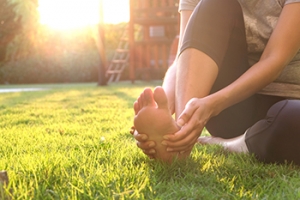Items filtered by date: October 2023
An Overview of Toenail Fungus
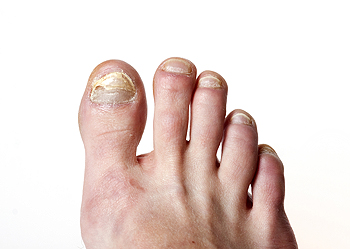
Toenail fungus, or onychomycosis, is a common but often underestimated condition that can affect individuals of all ages. It typically starts with a minor discoloration or a small white spot beneath the nail. As it progresses, the nail may become discolored, thickened, and brittle. In some cases, it can lead to pain and a foul odor. Toenail fungus is caused by various types of fungi that thrive in warm, damp environments, such as the insides of shoes. Factors like poor foot hygiene, compromised immune systems, and preexisting nail or skin conditions can increase susceptibility. Untreated toenail fungus can be aesthetically unpleasant and, in some cases, lead to complications. Early intervention is essential to prevent the condition from worsening. Understanding the basics of toenail fungus is the first step toward recognizing, treating, and preventing this ailment. If you have developed toenail fungus, it is strongly suggested that you are under the care of a podiatrist who can properly diagnose this condition, and offer treatment solutions that are right for you.
For more information about treatment, contact Dr. Kenneth Donovan of Advanced Care Foot and Ankle. Our doctor can provide the care you need to keep you pain-free and on your feet.
Toenail Fungus Treatment
Toenail fungus is a condition that affects many people and can be especially hard to get rid of. Fortunately, there are several methods to go about treating and avoiding it.
Antifungals & Deterrence
Oral antifungal medicine has been shown to be effective in many cases. It is important to consult with a podiatrist to determine the proper regiment for you, or potentially explore other options.
Applying foot powder on the feet and shoes helps keep the feet free of moisture and sweat.
Sandals or open toed shoes – Wearing these will allow air movement and help keep feet dry. They also expose your feet to light, which fungus cannot tolerate. Socks with moisture wicking material also help as well.
If you have any questions please feel free to contact one of our offices located in Warren, Livingston, and Toms River, NJ . We offer the newest diagnostic tools and technology to treat your foot and ankle needs.
Common Causes of Foot Pain
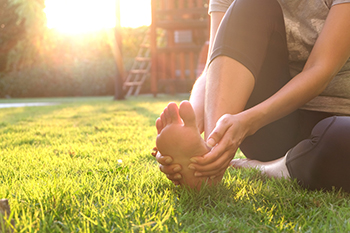
Your feet are remarkable, having carried you around an incredible 75,000 miles by the age of 50. However, they can develop wear-and-tear issues, leading to discomfort. Four common causes of foot pain are bunions, Morton’s neuroma, plantar fasciitis, and toenail fungus. Bunions are painful deformities often resulting from the misalignment of bones in the big toe. Causes include wearing narrow shoes, hereditary predisposition, or flat feet. Morton's neuroma is a pinched nerve condition that causes discomfort in the ball of the foot, between the third and fourth toes. It can be worsened by tight shoes and is often linked to other foot problems. Plantar fasciitis occurs when the ligament running from the heel bone to the base of the toes becomes inflamed, causing heel pain. Risk factors include high or low arches, obesity, tight Achilles tendons, and improper footwear. Toenail fungus can lead to nail deformities. Risk factors include sweaty feet, tight shoes, and exposure to fungus in public showers or pools. For help with any of the above foot pain issues, it is suggested that you make an appointment with a podiatrist who is medically trained to deal with them effectively.
Foot Pain
Foot pain can be extremely painful and debilitating. If you have a foot pain, consult with Dr. Kenneth Donovan from Advanced Care Foot and Ankle. Our doctor will assess your condition and provide you with quality foot and ankle treatment.
Causes
Foot pain is a very broad condition that could be caused by one or more ailments. The most common include:
- Bunions
- Hammertoes
- Plantar Fasciitis
- Bone Spurs
- Corns
- Tarsal Tunnel Syndrome
- Ingrown Toenails
- Arthritis (such as Gout, Rheumatoid, and Osteoarthritis)
- Flat Feet
- Injury (from stress fractures, broken toe, foot, ankle, Achilles tendon ruptures, and sprains)
- And more
Diagnosis
To figure out the cause of foot pain, podiatrists utilize several different methods. This can range from simple visual inspections and sensation tests to X-rays and MRI scans. Prior medical history, family medical history, and any recent physical traumatic events will all be taken into consideration for a proper diagnosis.
Treatment
Treatment depends upon the cause of the foot pain. Whether it is resting, staying off the foot, or having surgery; podiatrists have a number of treatment options available for foot pain.
If you have any questions, please feel free to contact one of our offices located in Warren, Livingston, and Toms River, NJ . We offer the newest diagnostic and treatment technologies for all your foot care needs.
Exploring Methods to Measure Foot Size
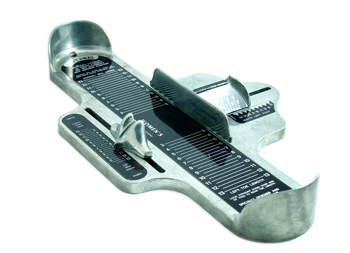
Ensuring your shoes fit comfortably is essential for overall foot health and mobility. Various methods can help you accurately measure your foot size to find the perfect size of shoes. The simplest approach is to use a ruler or a Brannock device, a common tool available in shoe stores. Be sure you measure both feet, as they may differ slightly in size. Alternatively, the sock test involves tracing your foot on a piece of paper while wearing socks, and then measuring their length and width. There are also smartphone apps designed to measure foot size using the device's camera. Remember to measure your feet later in the day when they may be slightly swollen, and consider the type of socks you plan to wear with your shoes. Accurate measurements ensure comfortable and well-fitting shoes, possibly reducing the risk of foot-related discomfort and problems. If you would like more specific instructions on how to measure your feet to obtain their proper size, it is suggested that you speak to a podiatrist who can provide you with useful information.
It is important to find shoes that fit you properly in order to avoid a variety of different foot problems. For more information about treatment, contact Dr. Kenneth Donovan from Advanced Care Foot and Ankle. Our doctor will treat your foot and ankle needs.
Proper Shoe Fitting
Shoes have many different functions. They cushion our body weight, protect our feet, and allow us to safely play sports. You should always make sure that the shoes you wear fit you properly in order to avoid injuries and deformities such as: bunions, corns, calluses, hammertoes, plantar fasciitis, stress fractures, and more. It is important to note that although a certain pair of shoes might be a great fit for someone else, that doesn’t mean they will be a great fit for you. This is why you should always try on shoes before buying them to make sure they are worth the investment. Typically, shoes need to be replaced ever six months to one year of regular use.
Tips for Proper Shoe Fitting
- Select a shoe that is shaped like your foot
- Don’t buy shoes that fit too tight, expecting them to stretch to fit
- Make sure there is enough space (3/8” to ½”) for your longest toe at the end of each shoe when you are standing up
- Walk in the shoes to make sure they fit and feel right
- Don’t select shoes by the size marked inside the shoe, but by how the shoe fits your foot
The shoes you buy should always feel as good as they look. Shoes that fit properly will last longer, feel better, and improve your way of life each day.
If you have any questions, please feel free to contact one of our offices located in Warren, Livingston, and Toms River, NJ . We offer the newest diagnostic and treatment technologies for all your foot care needs.
Custom Orthotics and Foot Health
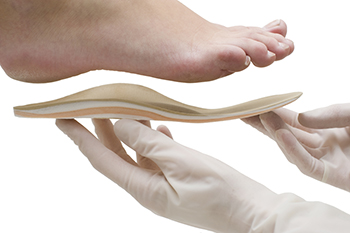
Orthotics are specialized shoe inserts, or insoles, designed to provide support, cushioning, and alignment to the feet. These custom-made devices are prescribed to individuals for various reasons, aiming to address a range of foot-related issues and improve overall foot health. One of the primary reasons to wear orthotics is to alleviate pain and discomfort associated with conditions such as plantar fasciitis, flat feet, or bunions. These devices can help distribute pressure more evenly across the foot, reducing strain and preventing further damage. Orthotics can also improve alignment, correct gait abnormalities, and support the arches. This can be beneficial for individuals with irregular foot structures or those who engage in high impact activities. Additionally, orthotics can aid in injury prevention by promoting proper biomechanics and reducing stress on the feet, knees, hips, and lower back. Orthotics can be a valuable tool for maintaining foot health, preventing injuries, and enhancing overall comfort and mobility. If you would like more information about the benefits of custom orthotics, it is suggested that you schedule an appointment with a podiatrist.
If you are having discomfort in your feet and would like to try orthotics, contact Dr. Kenneth Donovan from Advanced Care Foot and Ankle. Our doctor can provide the care you need to keep you pain-free and on your feet.
What Are Orthotics?
Orthotics are inserts you can place into your shoes to help with a variety of foot problems such as flat feet or foot pain. Orthotics provide relief and comfort for minor foot and heel pain but can’t correct serious biomechanical problems in your feet.
Over-the-Counter Inserts
Orthotics come in a wide variety of over-the-counter inserts that are used to treat foot pain, heel pain, and minor problems. For example, arch supports can be inserted into your shoes to help correct overarched or flat feet, while gel insoles are often used because they provide comfort and relief from foot and heel pain by alleviating pressure.
Prescription Orthotics
If over-the-counter inserts don’t work for you or if you have a more severe foot concern, it is possible to have your podiatrist prescribe custom orthotics. These high-quality inserts are designed to treat problems such as abnormal motion, plantar fasciitis, and severe forms of heel pain. They can even be used to help patients suffering from diabetes by treating foot ulcers and painful calluses and are usually molded to your feet individually, which allows them to provide full support and comfort.
If you are experiencing minor to severe foot or heel pain, it’s recommended to speak with your podiatrist about the possibilities of using orthotics. A podiatrist can determine which type of orthotic is right for you and allow you to take the first steps towards being pain-free.
If you have any questions please contact one of our offices located in Warren, Livingston, and Toms River, NJ . We offer the newest diagnostic and treatment technologies for all your foot and ankle needs.
Facts and Myths About Flat Feet

Flat feet, also known as pes planus, is a condition where the arches of the feet collapse, causing the entire sole to touch the ground. Contrary to common belief, flat feet are not always problematic or painful. Many individuals with flat feet experience no discomfort or other issues, leading active and fulfilling lives. However, some may face challenges such as foot pain or lower limb fatigue, especially if the condition alters their gait or posture. Flat feet can be hereditary, a result of injury, or develop over time due to wear and tear. Wearing proper footwear, practicing exercises to strengthen foot muscles, and using orthotic inserts can offer relief and support. Understanding the facts about flat feet can empower individuals to manage any associated concerns effectively and lead an active, healthy lifestyle. If you have flat feet, it is strongly suggested that you are under the care of a podiatrist who can help you to monitor this condition.
Flatfoot is a condition many people suffer from. If you have flat feet, contact Dr. Kenneth Donovan from Advanced Care Foot and Ankle. Our doctor will treat your foot and ankle needs.
What Are Flat Feet?
Flatfoot is a condition in which the arch of the foot is depressed and the sole of the foot is almost completely in contact with the ground. About 20-30% of the population generally has flat feet because their arches never formed during growth.
Conditions & Problems:
Having flat feet makes it difficult to run or walk because of the stress placed on the ankles.
Alignment – The general alignment of your legs can be disrupted, because the ankles move inward which can cause major discomfort.
Knees – If you have complications with your knees, flat feet can be a contributor to arthritis in that area.
Symptoms
- Pain around the heel or arch area
- Trouble standing on the tip toe
- Swelling around the inside of the ankle
- Flat look to one or both feet
- Having your shoes feel uneven when worn
Treatment
If you are experiencing pain and stress on the foot you may weaken the posterior tibial tendon, which runs around the inside of the ankle.
If you have any questions please feel free to contact one of our offices located in Warren, Livingston, and Toms River, NJ . We offer the newest diagnostic and treatment technologies for all your foot and ankle needs.

